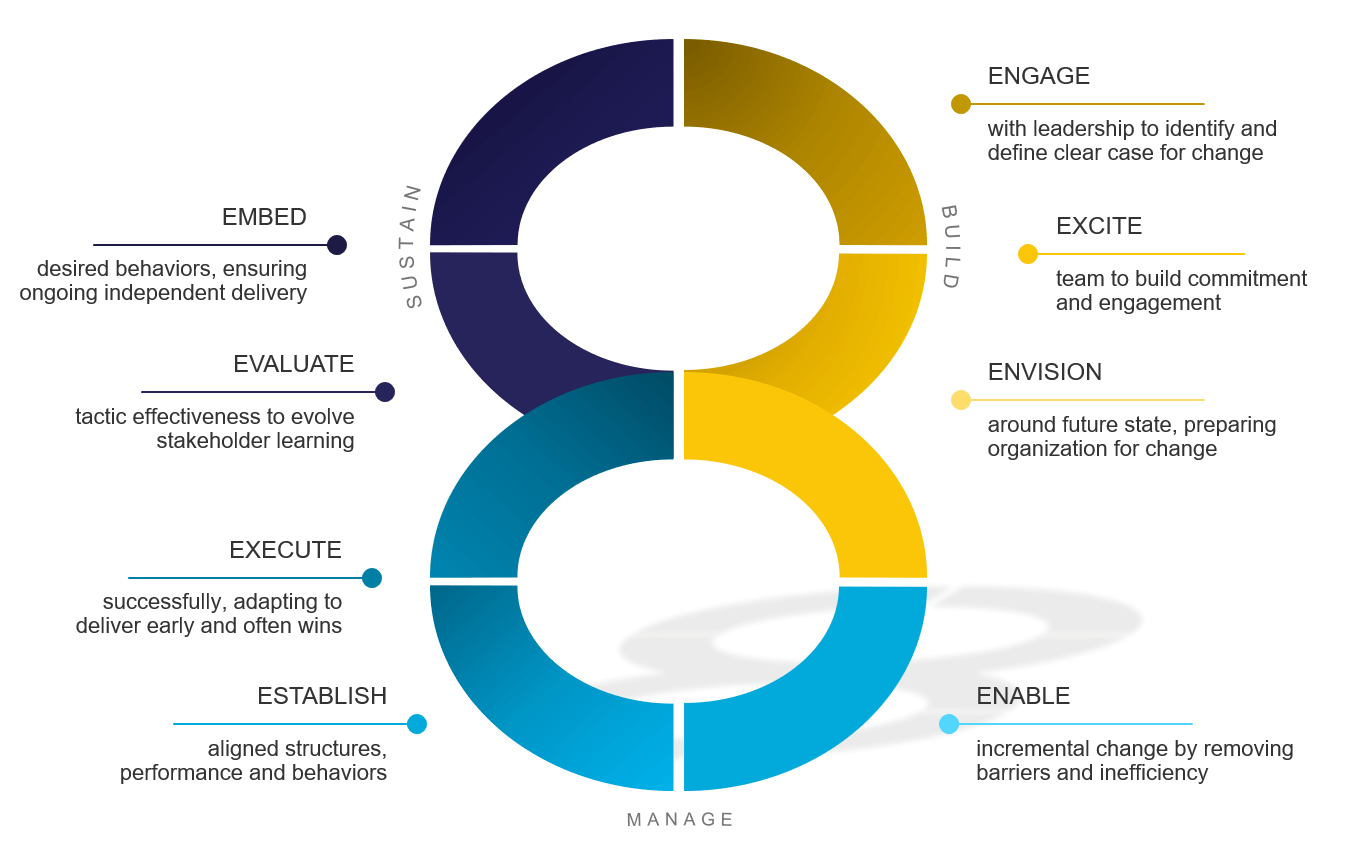Change Management theory and practice have been around for many years, yet many organisations still struggle with implementing change. While commonly cited that roughly 70% of change programs fail, it is only recently that organisations have started to realise that the successful delivery of their programmes is inextricably linked to the implementation of robust change management principles and interventions.
In this how-to guide, we cover what is change management and 5 key principles to increase the chance of your programme succeeding.
Change Management, also known as organizational change management, is the practice of effectively engaging stakeholders, minimizing risk to efficient adoption and maximizing benefits through a focus on the organizational, cultural and people aspects of business transformations.
To put it simply, it is the practice of ensuring that people actually start adopting any new initiative.
Some, therefore, prefer to refer to Change Management as Adoption Management as it is a bit clearer about what you intend to achieve. Only once people start using a new tool or process will you see any benefit from your investment.

So why now you may ask?
For the past few years, the pace of organisational change has increased as organisations adapt to market and consumer trends. There has been a significant focus on digital transformation and technology change. So not only do people need to change – they need to change faster in order to keep up with all the initiatives coming their way.
“Only once people start using a new tool or process will you see any benefit from your investment.”
Organisations looking to improve the speed of delivery of new products have turned to new ways of working like Lean Start Up and Agile methodologies. So, while the first factor was around technology and its impact on people, the second key factor is around process and the impact it has on people.
The final key factor is of course our own capability to respond to change. With the introduction of the coronavirus pandemic in 2020, there has never been a period of higher albeit forced change across the globe than now.
A proper appreciation of the value of Change Management is still evolving in some sectors and with some senior managers. It’s, therefore, important to be able to bring to life the benefits of implementing robust Change Management interventions. They must be in no doubt that these interventions will have a positive impact on business performance or, perhaps more pertinently, that not doing Change Management properly will have a negative effect on the business.
To make it more real, it is helpful to ask people to imagine an organisational programme that requires a budget of say £/$10 million. A programme of that magnitude would not be signed off unless it had a strong business case to support it, and the business case in turn would need to have a compelling set of benefits whether they be based around organisational efficiencies, increased competitive advantage or, more typically, a basket of factors.
Invariably, these benefits will be predicated on the vast majority of the business adopting the new ways of working. Most benefits are predicated on adoption rates of at least 90%, sometimes more. What happens, however, when adoption rates fail to hit that 90% mark, perhaps topping out at 60 or 70% or worse?
Where the Change Management has been suboptimal can happen for a number of reasons, such as poor levels of awareness due to insufficient or poor communications, lacklustre sponsor behaviours or perhaps an insufficient understanding of how the change would affect the business.
So now you have say 65% adoption where the business case was based on 90%. Immediately full benefits realisation becomes very difficult to achieve so that, with the best-case scenario, the programme is only seen as a partial success and in most cases is deemed a failure.
Projected benefits, and ultimately the bottom line, are affected by more than just low levels of adoption. Prosci, founder of the ADKAR® Model, found that organisations with immature Change Management interventions overran deadlines, cost more than expected to deliver and failed to meet all of their objectives. Even to the most cynical eye the benefits of good Change Management are hiding in plain sight if you know where to look.
Prosci recently surveyed over 1,778 change practitioners about the top trends facing the field of change management.
The top trends cited were:
Included in this greater need for change management training is an awareness or understanding of the various change management approaches.
We previously conducted a survey with 120+ organizations over a 5 year period. We found that three out of 10 projects saw increases in performance directly tied to an effective change management approach. Moreover, in large projects, the return on investment (ROI) was 6.5 times higher when an effective change management approach was in place.

Your change approach defines the phases that an organization will proceed through in transitioning from today’s current state to the defined future state.
There are several approaches or models, including Lewin’s Change Management Model, Kotter’s 8 step change theory, Prosci’s ADKAR model (introduced above) and we at MIGSO-PCUBED have one as well.
As highlighted in our article Change Management Best Practices: 10 Lessons Learned, it is less important which organizational change management methodology you pick; it is just critical that you pick one.
Our 8E Model includes and applies best practice elements to ensure an integrated, end-to-end approach. And, it is fully integrated with our Programme Transformation Model to help change managers understand where the program is and to identify any specific needs and challenges.

Using the 8E’s, our change practitioners are able to remove obstacles and rapidly put in place exactly what the program needs to be successful.
Project and Programme Management as well as Change Management are areas that have many synergies. Indeed, it could be argued that they are to a great extent symbiotic with each other. Even the best run Programme needs strong Change Management to drive adoption, and these Change Management interventions are aided significantly if deployed against a background of a well run project or programme with robust processes and controls.
Perhaps the best way of understanding the relationship is to consider that Change Management is the art that brings alive the science of Project and Programme Management.
Project and Programme Management thrive on creating a well organised environment where order is brought about by planning, process and adherence. Change Management looks at the hopes and fears of the stakeholders effected by this change, considers their individual propensity for change, the culture and hierarchy of their working environment, their neurodiversity and their role and creates tailored solutions that help each individual navigate the change journey.
Every time a change manager talks to a stakeholder or groups of stakeholders, they are almost like an artist with the potential interventions being their palette. It’s a different mix of that palette each time because whilst all change journeys are the same, each one is different and therein lies the art.
So, the best run projects and programmes successfully harness both the science and the art of programme delivery, the rigour of the former tailored into something compelling and personal by the sensitivity of the latter. It’s that combination which enables MP to deliver projects and programmes on time, fully realised and with high levels of adoption and evangelism amongst the workforce.
In our next article, we will walk you through the 5 key Change Management Principles that you need to focus on.
This article was written by James Lewis, Head of Change Management
"Change Management is the actual process of winning the hearts and minds of everybody who is affected by organizational change."
James Lewis, explainer video 🡪
Organizations are facing unprecedented levels of change. While the need to lead effective change is growing, so too is change fatigue. We get it, change is hard. Luckily, it’s a challenge we enjoy tackling.
Organizations are facing unprecedented levels of change. While the need to lead effective change is growing, so too is change fatigue. We get it, change is hard. Luckily, it’s a challenge we enjoy tackling.
We focus on the people aspect of organizational change, creating the right environment to allow transformation through.
We make sure you see value from all your hard work.

Engage leaders and define the Change Strategy and Plan.
Accelerated Change Management Start-up aligns leaders and key stakeholders around Change Management focus areas to drive effective and sustainable change.
The Change Management Strategy and Change Management Plan are two deliverables that uniquely build upon organizational context, strategy, strengths, and opportunities.
Ensure effective delivery and coordination of Change activities.
Change Management Delivery ensures Change Management activities are successfully prepared for, delivered, and evaluated to enhance user adoption, utilization and proficiency. Change Management Delivery is tightly integrated with program or project milestones and delivered through organizational stakeholders to achieve maximum benefits.
Assess the impact of change and the organization’s readiness for change.
Change Management Assessment identifies and addresses risks and resistance that might cause projects to fail, or have caused past failure.
Take active steps to address obstacles and establish a stakeholder assurance plan to ensure stakeholders are kept engaged and informed on the progress of Change Management-related activities.
Ensure customer success in technology implementation by enabling user adoption.
Technology Adoption Success is an approach that leverages adoption and change management to maximize user adoption and proficiency of new technology or systems.
This is a tried-and-tested method of engaging users and changing the way they fundamentally think, feel, and eventually use the new system to uncover its benefits.
We ensure our Technology Adoption Success approach is tightly integrated with the technical implementation roadmap to deliver sustainable and long-term adoption and utilization.
Our three phased Change Management Model is seamlessly integrated with our own Program Management Transformation Model.
All change activities are tailored to the organization’s specific requirements, aimed at driving adoption, enhancing delivery performance and embedding lasting change.
Our APMG accredited Change Management Foundation and Practitioner training can help your organization grow its change management capability. The courses provide an excellent grounding in the theory and application of change management concepts and include plenty of opportunities for discussion and group activities to put learning into an organizational context.


We combine our expertise with a fine knowledge of the industry to deliver high-value project management services.
MIGSO-PCUBED is part of the ALTEN group.
Find us around the world
Australia – Canada – France – Germany – Italy – Mexico – Portugal – Romania – South East Asia – Spain – Switzerland – United Kingdom – United States
© 2024 MIGSO-PCUBED. All rights reserved | Legal information | Privacy Policy | Cookie Settings | Intranet
Choose your language
Our website is not supported on this browser
The browser you are using (Internet Explorer) cannot display our content.
Please come back on a more recent browser to have the best experience possible
